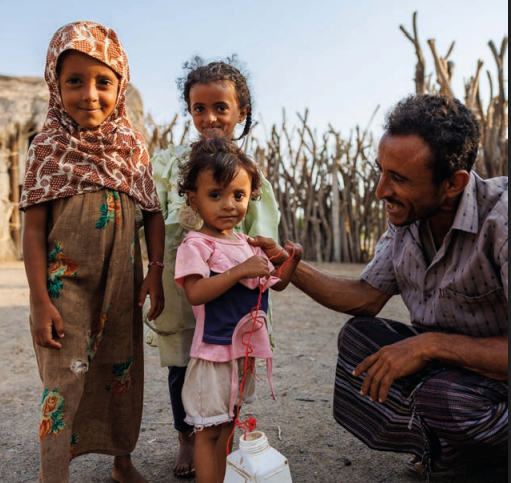Wars are increasingly deadly for children: nearly 50,000 victims in the last five years
A new Save the Children report shows how explosive weapons have become the leading cause of death and maiming of children in today’s wars. New technologies amplify the risks (rather than improve accuracy), while mines and unexploded ordnance continue to strike, especially in Afghanistan and Myanmar. The NGO urgently calls for cuts in the use of explosives in populated areas and real funding for land reclamation and children rehabilitation and protection.
Milan (AsiaNews) – The use of explosive weapons has become one of the main threats to the survival and future of children in countries at war, this according to a new report by Save the Children.
The study, Children and Blast Injuries: The devastating impact of explosive weapons on children 2020–2025, captures a world of childhoods destroyed by explosive devices used in today’s wars.
According to United Nations data analysed in the report, in 2024 alone, nearly 12,000 children were killed or injured in war, the highest number ever recorded, mainly in the Gaza Strip (2,917), followed by Sudan (1,739), Myanmar (1,261), Ukraine (671), and Syria (670).
In Gaza, at least 21,000 children now have permanent disabilities, the highest number of childhood amputations ever recorded in a single documented conflict.
Between 2020 and 2024, child war victims reached nearly 50,000, the equivalent of about 200 planes full of children, according to Save the Children.
In over 60 per cent of cases, explosive weapons are the cause of death or amputation: aerial bombardments, shelling, improvised or unexploded ordnance, which continue to threaten the lives of civilians even many years after the cessation of hostilities.
The latest technologies have exacerbated the situation, tragically increasing the risks for children. At the same time, contemporary wars are increasingly fought in densely populated urban areas with weapons designed to have devastating effects on a large scale. This has multiplied children's exposure and the severity of their injuries, as well as normalised civilian deaths.
Among these technologies are, for example, "first-person view" drones, small remotely piloted aircraft modified to carry explosive charges and guided by a real-time visual feeds; or loitering munitions, also called “suicide drones”, capable of hovering over an area for a long time before self-detonating.
Presented as "precision weapons," their use in urban areas makes it impossible to control secondary explosions.
Added to this are the growing use of cluster munitions (in 2024, all recorded cluster munition victims were civilians, and 42 per cent of victims of remnants were children) and the use of artificial intelligence in weapons systems, which allows targets to be selected and "life-or-death" decisions to be made at a speed incompatible with adequate human control.
All these developments, combined with the growing tendency to bomb densely populated areas, have the effects that the report sees as mathematically predictable.
When explosive weapons are used in cities, 95 per cent of those affected are civilians, and 97 per cent of incidents involve children.
In short, modern warfare technology has not reduced collateral damage, but has made it more precise, more frequent, and more inevitable.
The report also emphasises one point: children are not miniature adults. Their bodies are smaller, their bones are growing, their organs are more fragile. All of this makes them more vulnerable to the effects of blast waves and shrapnel.
Studies summarised by Save the Children and the Centre for Paediatric Blast Injury Studies show that minors are more likely to die from blast injuries.
Most children injured by blasts, however, have multiple injuries that require complex interventions and lengthy rehabilitation.
Because the body continues to grow, amputations and poorly healed fractures can mean dozens of surgeries over the course of a lifetime, frequent replacement prostheses, chronic pain, and social isolation.
And psychological consequences often accompany physical injuries.
Despite this, protection policies continue to treat children like ordinary civilians; their specific vulnerability is almost completely ignored in military doctrine, and funding for assistance is limited.
In 2023, only 6 per cent of global funding for mine and unexploded ordnance action was allocated to victim assistance, and just 1 per cent to risk education.
In Asian countries caught up in modern conflicts, landmines are the main problem.
In Myanmar, since the outbreak of civil war in 2021, many regions of have become almost impassable for children, who account for nearly a third of all mine and unexploded explosive victims – many are blown up on their way to school, helping in the countryside, or playing in the fields.
UNICEF data show a steady increase in child victims: 74 in 2021, 133 in 2022, 226 in 2023, and 314 in 2024. In the first three months of 2025, 58 new cases have already been recorded, a sign that the trend shows no signs of slowing.
War in Myanmar is increasingly violent, partly due to air strikes, which jumped from 640 in all of 2024 to 1,134 in the first five months of 2025 alone.
In Afghanistan, despite the end of the war in 2021 following the Taliban's takeover of the country, more than 50 people are killed or maimed every month, mostly children.
At least 6.4 million Afghans live surrounded by mines and unexploded ordnance.
Between August 2021 and May 2023, the UN mission in Afghanistan (UNAMA) documented 3,774 civilian casualties.
In 2024, unexploded ordnance became the leading cause of death and injury among children.
Growing poverty and the need for child labour partly explain these tragic numbers – most children find unexploded ordnance while herding cattle, working in the fields, or collecting scrap metal to sell.
Eight out of ten victims are boys, because they are more likely to be outdoors than girls.
Humanitarian organisations estimate that 4.4 million people will require mine action services (clearance, risk education, and victim assistance), a 5 per cent increase over the previous year.
For an Afghan child who survives an explosion, the journey does not end with leaving the hospital; it continues in a country where streets, fields, and even schoolyards can hide new ordnance.
Afghanistan and Myanmar are two emblematic cases of a broader crisis. The report notes that children account for 43 per cent of mine and explosive remnant victims globally; what is more, these weapons can remain active for decades in fields, streets, schools, and homes.
Save the Children believes at least three immediate actions are needed to reverse this trend: drastically reduce the use of explosive weapons in populated areas; seriously fund clearance, victim assistance, and child-friendly psychosocial support; and recognise, in political and military decisions, that children are not inevitable collateral damage, but rather those who pay the highest price for today's and tomorrow's wars.
24/10/2022 15:30
11/03/2021 14:00







.png)










